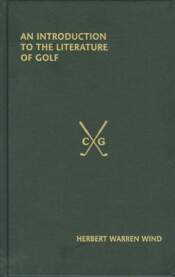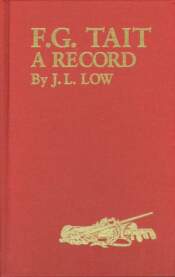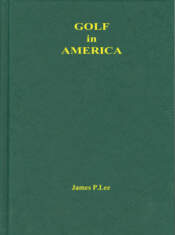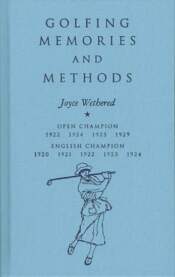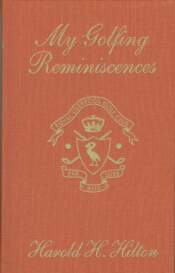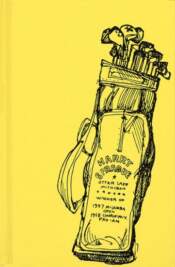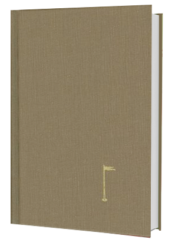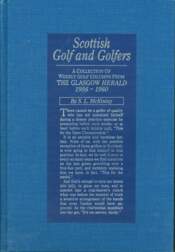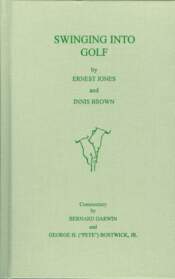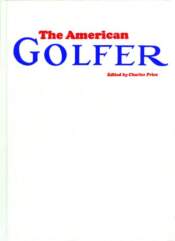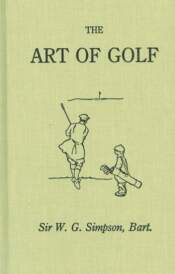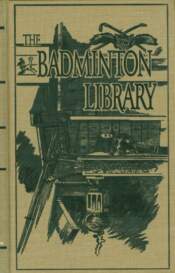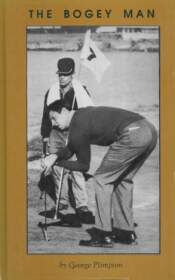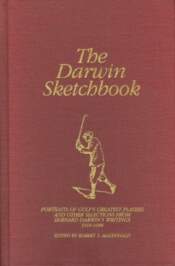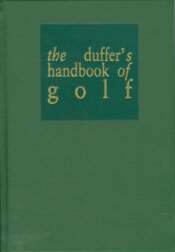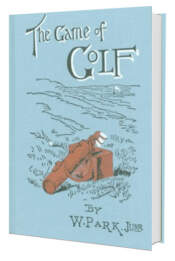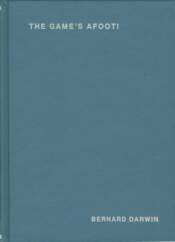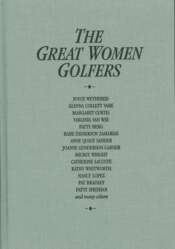-
 Unwritten in the annals of the sporting world is the story of a man with unlimited potential who was denied his rightful place in the lore of golf. Who was this mysterious golfer with a golden swing and deft touch, who life and career Bobby Jones followed with so much interest? An accused felon fleeing from the law? Why would one of the greatest athletes of all time risk his spotless reputation to help a man he met only once? "Golf's literary rookie of the year" --New York Times, "Veron proves to be a master of fiction." --USA Today, "Dual parts John Grisham and John Feinstein." --Seattle Post-Intelligencer, "If you have ever played one round of golf, and appreciate clear, spare writing with a touch of To Kill A Mockingbird, you will love this book." --Miami Herald
Unwritten in the annals of the sporting world is the story of a man with unlimited potential who was denied his rightful place in the lore of golf. Who was this mysterious golfer with a golden swing and deft touch, who life and career Bobby Jones followed with so much interest? An accused felon fleeing from the law? Why would one of the greatest athletes of all time risk his spotless reputation to help a man he met only once? "Golf's literary rookie of the year" --New York Times, "Veron proves to be a master of fiction." --USA Today, "Dual parts John Grisham and John Feinstein." --Seattle Post-Intelligencer, "If you have ever played one round of golf, and appreciate clear, spare writing with a touch of To Kill A Mockingbird, you will love this book." --Miami Herald -
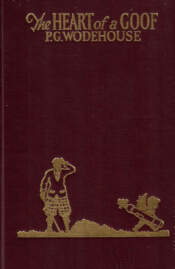 The Heart of a Goof (1926) by P.G. Wodehouse Heart of A Goof offers nine of Wodehouse’s ripest stories from the 1920s, the characters are united by their worship of golf. From Rodney Spelvin, the sickeningly good-looking romantic poet who comes to his senses when he discovers the game, to Rollo Podmarsh, who finishes his round even when he thinks himself fatally poisoned, and Chester Meredith who discovers eloquence on the eighteenth green, we meet the full range of humanity in fair weather and foul.
The Heart of a Goof (1926) by P.G. Wodehouse Heart of A Goof offers nine of Wodehouse’s ripest stories from the 1920s, the characters are united by their worship of golf. From Rodney Spelvin, the sickeningly good-looking romantic poet who comes to his senses when he discovers the game, to Rollo Podmarsh, who finishes his round even when he thinks himself fatally poisoned, and Chester Meredith who discovers eloquence on the eighteenth green, we meet the full range of humanity in fair weather and foul. -

$35.00Add to cart
By Bernard Darwin
A HISTORY OF GOLF IN BRITAIN was an effort on the part of the best English writers to put out a definitive history of the game of golf in Great Britain. The best English writer, in fact the best golf writer ever, Bernard Darwin, acted as general editor of the project as well as contributing two long essays: THEN AND NOW and FROM GUTTY TO RUBBER-CORE.
Henry Cotton is a highly intelligent analyst and instructor and wrote his own material as so few successful professionals have done. Henry Longhurst writes entertainingly and with a perspective all his own, and his chapter BETWEEN TWO WARS deals mainly with the Americans, Hagen, Jones, and Sarazen, for it was they who dominated this period of British golf. Leonard Crawley is an excellent writer; the focus in A FRESH START is mainly British; for American tastes there is some wonderful writing on the Walker Cup and Ryder Cup matches. WOMEN'S GOLF, by Enid Wilson, is a gem, dealing with the American stars as comprehensively as with the British and writing with real perception and understanding - a brilliant chapter. THE FUTURE OF THE GAME is in many ways an odd chapter, but it is the 'piece de resistence' in the book. Coming at golf from a scientific point of view, Lord Brabazon asks what it is we like about the game and how are we going to preserve what we like? The game is changing, he believes, and is in danger of leaving behind some of its most enjoyable aspects. He suggests certain innovations that stagger one by their originality and obviousness.
Lord Brabazon of Tara When after the Second World War, Churchill wished to reward Moore-Brabazon for his extraordinary help as Minister of Aircraft Production, he recommended him for a barony. Moore-Brabazon accepted with pleasure. "To be made a Peer," he wrote, "is a great privilege because we are still a very snobbish people." That is the way Moore-Brabazon looked at things: with legendary self-honesty. He wanted Brabazon to be part of his title because the name had been enscrolled on the Battle of Hastings in 1066, but he needed an "of" because someone else already had Brabazon, so he selected "of Tara". He liked the ring of the words.
As a young man, Lord Brabazon became in 1909 the first English aviator, i.e. the first Englishman to fly a plane in England. He was one of the major pioneers in the development of the airplane in the British Isles and, indeed, in the world. He virtually invented the art of aerial photography during World War I. He was not a politician - the deviousness necessary to survive in office was totally lacking in him - but Churchill needed him during World War II, first as minister of transport and then, following the terrifying Lord Beaverbrook, as minister of aircraft production. Beaverbrook was inspirational and singlehandedly ran every aspect of the ministry, but there was a lack of planning, which was Lord Brabazon's strong suit. He understood in his supremely practical way that no matter how many planes you were turning out, it did you no good if certain small parts were missing. You had planes but they couldn't fly. If, on the other hand, you could find out three or four months before delivery what parts were likely to be in short supply, you would then have time to correct the shortage. A great many planes began coming off the assembly lines ready to fly, and this is one of the reasons England won the Battle of Britain and turned the tide of the war.
Eventually Lord Brabazon's lack of political skills did him in. Misquoted about England's relationship with Russia, he became a target of the trade unions, and Churchill finally had to ask him to resign in order to calm the political waters. He did so with relief and without regret.
He learned golf when he was twenty-six and worked so diligently at the game that he got down to a scratch handicap, but he was not a really find golfer, and he knew it. He enjoyed Roger Wethered's description of him as "the best bad golfer in England". He was proudest of being elected Captain of the R. & A. in 1952-53. The Captain is inaugurated by his driving off the first tee of St. Andrews in front of a huge crowd and a group of caddies who wait for the traditional golden sovereign given to whichever of them retrieves the ball. The caddies gathered downfield about two hundred yards, but Lord Brabazon dribbled one off the tee, and the caddies had to race in well over half way. It was an embarrassing moment. At the great banquet that night, Lord Brabazon announced that he had hit the grounder on purpose as an encouragement to all bad golfers, and then he added, after a few moments of dreadful silence, "If you believe that, you'll believe anything."
Lord Brabazon had a most simple and direct ethic: whatever you enjoy, you have an obligation to make better, if you can. He served tirelessly on many committees that were established by the R. & A., the governing body of golf. It was perhaps through his committee work that he got to know Bernard Darwin. He played golf with Darwin, which was somewhat like working for Churchill - an often terrifying experience. "I once played for the Oxford and Cambridge Golfing Society and Bernard was our Captain. He did me the great honour of letting me play first, and I played with him in the foursomes. It was a lovely day; we had the pleasantest of opponents; the birds were singing; the course was beautiful; and the whole thing was pure and utter joy. We were not doing so well and, about six holes from the end, I put Bernard in the rough. He beckoned me to follow him, and I got the most appalling dressing down I have ever had. He told me kindly to remember that we were playing for the Oxford and Cambridge Society, and that this was not a `jolly' but a very serious match, and would I please concentrate on it and not make silly remarks or fool around. . . that was Bernard all over. He never played a match in his life that wasn't as much to him as if he were playing in the Walker Cup."
In reflecting on his life, Lord Brabazon had this to say, "When I look back and try to decide out of what I got the most actual pleasure, I have no doubt that I got more out of golf than anything else." His essay, THE FUTURE OF THE GAME, is one of the most important ever written about the game of golf. We need him today. Many of us suspect that golf is changing and not changing for the better, but we cannot think about it as clearly as Lord Brabazon did or as Bernard Darwin did, for they were ones of a kind. How nice it is to have them together in one volume.
Foreword by Herbert Warren Wind and Sir George Cunningham
-
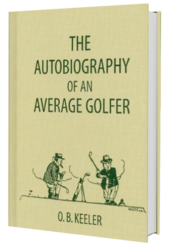
$35.00Add to cart
By O.B. Keeler This Atlanta sportswriter gained fame of his own by covering Bobby Jones in all his important tournaments. Jones considered Keeler to be 'the greatest sportswriter who ever lived.' He tells of his learning golf in 1897 and life in America before World War I. You will quickly see why Jones held him in such high regard. Foreword by Robert S. Macdonald. -
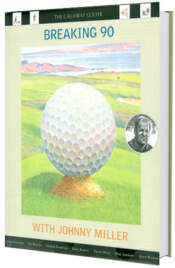 By Johnny Miller Superb instruction and piquant commentary from one of the most articulate premier players. As beautiful as it is useful, the book is printed on fine stock and profusely illustrated with original golf watercolors by Matthew Cook. Includes humorous essays by the likes of George Plimpton, David Owen, Charles McGrath, Glen Waggoner and Ian Frazier.
By Johnny Miller Superb instruction and piquant commentary from one of the most articulate premier players. As beautiful as it is useful, the book is printed on fine stock and profusely illustrated with original golf watercolors by Matthew Cook. Includes humorous essays by the likes of George Plimpton, David Owen, Charles McGrath, Glen Waggoner and Ian Frazier. -
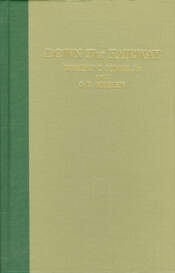
$40.00Add to cart
By Robert T. Jones, Jr., and O.B. Keller How would you feel if, as a first-time participant, you were leading the United States Amateur Championship field after the initial qualifying round? Kids dream themselves into those roles, but one kid found himself living that dream: Robert Tyre Jones, Jr., age-14*. With a storybook beginning like that, you know this golf book is going to be a bestseller. Here is Jones’ life story, full of more drama than a paperback thriller, written at the ripe old age of 24. If it were fiction, the editor would have rejected it for being too fantastic. Quoting Grantland Rice, “The start of Bobby Jones’ career to date is one of the most interesting episodes in all sport, one of the most unusual of all careers…back of this amazing skill there have also been character, magnetism, courage, and intelligence of a high order.” * Jones informally signed his name “Bob” and his friends used “Bob.” The press and the general populace most often used “Bobby,” and although Jones did not particularly like that nickname, he surely got used to it. Jones wrote Down the Fairway after his pair of victories in the 1926 British and U.S. Open Championships. It was an accomplishment previously unachieved and he felt he was at the peak of his game and his career. Now the world knows even more records would fall, but having bested the finest professional players included twice on the world stages it was hard to foresee higher pinnacles. He was playing as an amateur but he knew he was masquerading. As a student at Emory University Law School with Bachelor of Science degrees from Georgia Tech and Harvard, he was looking forward to the legal profession and eventually a family. He felt graciously indulged by his father, who had been denied a professional baseball career with Brooklyn in the National League by his father, Bobby’s grandfather and namesake, Robert Tyre Jones. Banner headlines aside, Bobby Jones knew he was a part-time amateur, and felt he probably had taken his golf game as far as it could, and possibly should, go. Tally to 1926: 120 trophies and 30 medals. Jones writes of an idyllic boyhood with golf being just one of the games of play. “I liked baseball much better,” he wrote, but played a home-made two-hole golf course “because of a dearth of boys in the neighborhood with whom to play baseball.” Eventually he joined his parents at the East Lake club, playing a few shots per hole with his first club, a cut-down second-hand cleek. He took to following the new pro Stewart Maiden around the course, although “He said very little and I couldn’t understand a single word of what he said.” According to his father, Bobby “was a natural mimic in those days,” and he must have been. At age-nine, he won the Junior Championship of the Atlantic Athletic Club. There are moments of epiphany in life and Jones records one: when he discovered the scorecard. He had always played to defeat his young opponent, especially if it was his good friend Perry Adair. During one such contest, Jones was winning and playing so well he forgot about Adair, and concentrated only on his score. When it resulted in a personal best of 80, Bobby not only felt elated, but also realized that “the toughest opponent of them all—Old Man Par” would always be ready for a game. A loss to that imaginary opponent might be inevitable, but that was fine, because as he writes, “I never learned anything from a match I won.” Jones was Georgia State Amateur Champion as “a chunky boy of 14.” Around that time Jones had his second golf epiphany: “There are two kinds of golf: golf—and tournament golf. And they are not at all the same thing.” It is more than the physical exertion. “I can play 36 holes of golf every day for two weeks and weigh the same at the end” says Jones. Nevertheless, in competition, “I always lose from ten to fifteen pounds in a championship of three or six days’ duration.” That Jones wanted to win with every fiber of his being was never in doubt, and that was part of his attraction. He was the real deal, a genuine phenomenon: everyone wanted to meet him or watch him play. Jones’ recollections of his matches are exciting, highlighting some great players and personages of the day. However, true to a Hollywood script, there were seven lean years until Jones’ fantastic 1926 season. Even Jones found it odd that he began his best year “with one glorious licking and closed it with another.” (Walter Hagen delivered one thrashing and George Von Elm the other.) Part Two of the book is instructional, an often forgotten but important section of his autobiography. Like Part One, it is simple to see why Jones’ swing was strong and lasting. Bobby’s tuition is facilitated by anecdotes and incidents concerning particular shots he is teaching. Easy to read and understand, the methods he describes are his own. While Jones does not suggest copying his physical swing, he does feel the mental side is very similar for everyone and the most difficult to conquer. Duff shots are not the sole property of the beginner. When at Merion preparing for his first national amateur, baffled by the fast greens, Jones actually putted off one green into a brook! Read why Jones liked to put the ball on the green as soon as possible when chipping; or why he felt the free body turn was the most important factor in his swing. These and many more explanations await the student. A Chronology of Jones’ golf events is a fitting conclusion to the text. How many guessed his career had hardly begun when this book was issued? For the final chapters of Bobby Jones’ life one must turn to his 1960 book, Golf is My Game (a Classics of Golf title), where, among many other events, the story of the 1930 Grand Slam is retold. For now, enjoy Down the Fairway: The Golf Life and Play of Robert T. Jones, Jr. which is, according to the esteemed Herbert Warren Wind, simply “the best book about golf ever written.” Foreword by Herbert Warren Wind, Afterword by Francis M. Bird. -
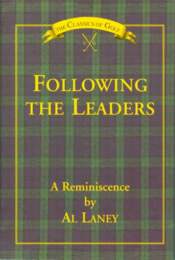 The important golf tournaments are covered of course and covered with real zest, but the centerpiece in Following the Leaders is always the personalities of the stars - how they react to pressure, how they conduct themselves when they are behind or ahead, how they prepare for championships, what their life is like off the course, how they see the world and each other. I think we probably get to know Jones, Sarazen, Collett, Wethered, Hagen, Hogan, Venturi, and Nicklaus better in these pages than other golf books. Laney knew them all. Bob Jones became one of his closest friends.
The important golf tournaments are covered of course and covered with real zest, but the centerpiece in Following the Leaders is always the personalities of the stars - how they react to pressure, how they conduct themselves when they are behind or ahead, how they prepare for championships, what their life is like off the course, how they see the world and each other. I think we probably get to know Jones, Sarazen, Collett, Wethered, Hagen, Hogan, Venturi, and Nicklaus better in these pages than other golf books. Laney knew them all. Bob Jones became one of his closest friends. -
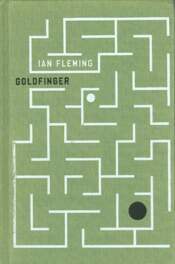 By Ian Fleming The 7th of the Bond thrillers - at its center is the description of the match between 007 and Goldfinger. One of the bestselling golf books of all time according to Valuable Golf. This book is a must for all golfers. The foreword by Robert Green describes Fleming's game and the venues used in the film.
By Ian Fleming The 7th of the Bond thrillers - at its center is the description of the match between 007 and Goldfinger. One of the bestselling golf books of all time according to Valuable Golf. This book is a must for all golfers. The foreword by Robert Green describes Fleming's game and the venues used in the film. -
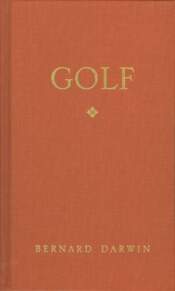
$35.00Add to cart
By Bernard Darwin The most prolific golf writer and high amateur, Darwin explains the multiple and enduring pleasures of golf in his own words and through writings culled from his favorite books on the game. You cannot possibly have a better guide. Foreword by Ian Dunlop. -
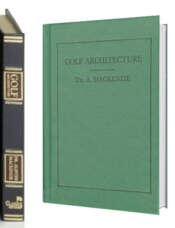
$75.00Add to cart
By Dr. Alister MacKenzie Dr. MacKenzie’s Golf Architecture was a monumental book for its time, a timeless book on golf architecture and a must for any student of the field or serious player. MacKenzie was an outdoorsman, a military man, and a doctor of medicine, whose hobby of golf architecture got the best of him. He ultimately abandoned his medical career to pursue golf course architecture and we must be thankful for that. He fully understood the nuances of the game but his genius was borne from his astute analysis of the nature of the course, its purpose and place in golf. One of the elemental distinctions he made was between strategic hazards (primarily sand bunkers, as he abhorred water as a penalty) and random hazards, as were commonly found on Scottish links—most notably at his beloved St. Andrews. The penal school of architecture was in vogue during much of MacKenzie’s life but he would have none of it. His conception of a perfect course had to do with surrounding the player, frequently challenging him, but ultimately enabling him the freedom to play, to enjoy his day at golf. MacKenzie felt too many golfers looked on hazards “as a means of punishing a bad shot, when their real object is to make the game interesting.” When his masterpiece, Augusta National Golf Club opened there were only 23 bunkers, barely more than one per hole. “Hazards should be placed with an object, and none should be made which has not some influence on the line of play...” While he is in complete agreement with John L. Low’s 1903 comment in Concerning Golf that no hazard is unfair wherever it is placed, MacKenzie avows “a hazard placed in the exact position where a player would naturally go is frequently the most interesting situation, as then a special effort is needed to get over or avoid it.” In one of the lectures that constitute this volume, MacKenzie identifies thirteen quintessential traits of the best golf architecture—the thirteen commandments for the zealous. Some are elementary: the next tee should be nearby the last green and in a direction away from following players; every hole should be of a different character and every course should have four par-threes, a couple of drive-and-pitch holes, but mostly substantial par-fours. Many qualities are more complicated: “The course should be so arranged so that the long handicap player, or even the absolute beginner, should be able to enjoy his round in spite of the fact that he is piling up a big score.” Besides ranking as one of the finest volumes on golf architecture, this book is valuable for the good course management it teaches, especially to those neophytes. Golfers must use their minds and act with authority; after all, this is war. MacKenzie was a military specialist in camouflaging earthworks; it was that peculiar skill that shaped his concepts for strategic bunkering. MacKenzie’s simple formula for a good golf course is twofold: it must never become monotonous; and the best course construction is “almost entirely due to utilization of natural features to the fullest extent and to the construction of artificial ones indistinguishable from nature.” He was also one of the earliest proponents of hazards to putting, designing unique greens such as the seventeenth at Augusta where the vertical halves slope in opposite directions, or the fifth with its backward tiering. He wanted the route to the green to be generous, never lined with ball-gobbling rough or ponds, but he could also be audacious when given property with substantially different terrain, as on the Monterey Peninsula for Cypress Point. Wisely there, the green movement is more tempered due to the high risk factor of many other shots, and perhaps the distracting drama of the surrounds. Admirers of the art of Mackenzie in the U. S. should also view Ohio State University GC, the University of Michigan GC and Crystal Downs CC, Green Hills CC (CA ), Pasatiempo GC, Northwood GC and Stockton G & CC. While totally serious and eminently important, this book is far from a chore to read. Although a stern, physically imposing Scot, MacKenzie liked a joke, even if at possibly his own expense. One of two rival green shapers admitted he could never quite achieve the subtle contours of the other, and asked his secret. “The other replied that it was perfectly easy; he simply employed the biggest fool in the village and told him to make them flat.” Foreword by Herbert Warren Wind, Afterword by Lewis A Lapham. -
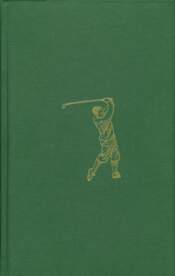
$40.00Add to cart
By Bobby Jones This is Bobby Jones' second and final autobiography. From 1923 to 1930, Jones won 13 national championships, and from 1922-1930 he was first or second in the U.S. Open, save one year. The impossible was accomplished by Bobby Jones in the magical year of 1930 when he won the British Amateur and Open Championships and the U. S. Amateur and Open Championships. Shortly thereafter, Bobby Jones announced he would play no more tournament golf, enigmatically stepping from the loftiest of competitive heights into the annals of golf history. Foreword by Bernard Darwin. -
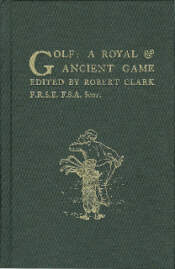 Edited by Robert Clark This is one of the earliest books on golf (1875) and the first history of the game. Robert Clark, an Edinburgh printer, did a phenomenal job gathering together all the best literature and documents that had been published or printed up to that time, all describing an exclusive and provincial Scottish game that no one in their right mind could imagine would someday spread around the world. If you have any interest in the history of the game, you have to get to know Clark’s book. Among other treasures, it contains “The Goff”, the famous poem which, when published in 1744, became the first book devoted entirely to golf. Foreword by William Gifford.
Edited by Robert Clark This is one of the earliest books on golf (1875) and the first history of the game. Robert Clark, an Edinburgh printer, did a phenomenal job gathering together all the best literature and documents that had been published or printed up to that time, all describing an exclusive and provincial Scottish game that no one in their right mind could imagine would someday spread around the world. If you have any interest in the history of the game, you have to get to know Clark’s book. Among other treasures, it contains “The Goff”, the famous poem which, when published in 1744, became the first book devoted entirely to golf. Foreword by William Gifford. -
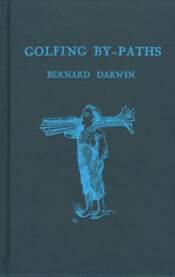
$40.00Add to cart
By Bernard Darwin Golfing By-Paths, long out of print and little known in the U.S., is a collection of 58 essays written by the great British golf writer between 1939 and 1945. “In these essays you can see Darwin endeavoring to keep the flame of golf alive amidst the privations of war,” says Classics of Golf Publisher Michael P. Beckerich. “He falls back on his memories of golf as a pillar English social life, the club as a haven, and allows himself some hope that these pleasures will not be totally lost.” This book showcases the amazing talent of Darwin's gift of writing. Foreword by Michael P. Beckerich. -
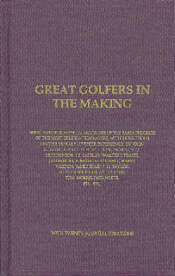 Edited by Henry Leach Autobiographical accounts of the early progress of the most celebrated players, with reflections on the morals of their experience by John L. Low, Harold H. Hilton, Horace G. Hutchinson, J.E.Laidlay, Walter J. Travis, James Robb, Edward Blackwell, Harry Vardon, James Braid, J.H. Taylor, Alexander Herd, Willie Park, Tm Morris, Jack White and others. Fascinating first person accounts of the greatest players. Foreword by Robert S. Macdonald.
Edited by Henry Leach Autobiographical accounts of the early progress of the most celebrated players, with reflections on the morals of their experience by John L. Low, Harold H. Hilton, Horace G. Hutchinson, J.E.Laidlay, Walter J. Travis, James Robb, Edward Blackwell, Harry Vardon, James Braid, J.H. Taylor, Alexander Herd, Willie Park, Tm Morris, Jack White and others. Fascinating first person accounts of the greatest players. Foreword by Robert S. Macdonald. -
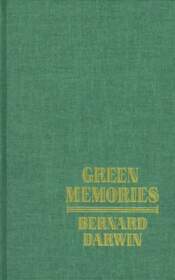
$40.00Add to cart
By Bernard Darwin The first of three autobiographies by the greatest golf writer of all time. This book is widely considered one of Darwin's best efforts which means it is one of the best golf books ever written. Indispensable for any golf library. Forewords by Bill Scheft and John Hopkins, golf correspondent for the London Times. -
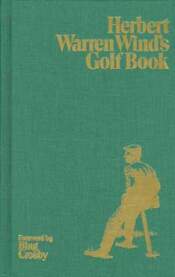 By Herbert Warren Wind A stirring collection of magazine articles and excerpts assembled only the way Herbert Warren Wind can. Wind offers his thoughts on Hogan, Snead, Venturi and Darwin, among others. They inspired thousands of golfers and set the standards for the golf writers that followed. This collection contains some of his most famous pieces on the great players, tournaments, golf architecture, turning points in the history of the game, and unusual aspects of golf that no one else bothered to write about . The story of one of the Triumvirate who, at the turn of the century, along with Taylor and Vardon, elevated the game from a Scottish curiousity to a level of unimaginable popularity, North to the Links of Dornach”, “The 1964 United States Open: The Third Man”, and “Some Thoughts on Golf Course Architecture”. The best from America’s best golf writer. Foreword by Bing Crosby.
By Herbert Warren Wind A stirring collection of magazine articles and excerpts assembled only the way Herbert Warren Wind can. Wind offers his thoughts on Hogan, Snead, Venturi and Darwin, among others. They inspired thousands of golfers and set the standards for the golf writers that followed. This collection contains some of his most famous pieces on the great players, tournaments, golf architecture, turning points in the history of the game, and unusual aspects of golf that no one else bothered to write about . The story of one of the Triumvirate who, at the turn of the century, along with Taylor and Vardon, elevated the game from a Scottish curiousity to a level of unimaginable popularity, North to the Links of Dornach”, “The 1964 United States Open: The Third Man”, and “Some Thoughts on Golf Course Architecture”. The best from America’s best golf writer. Foreword by Bing Crosby. -
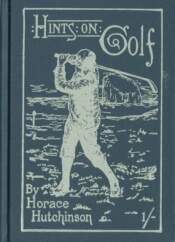 By Horace Hutchinson Foreword by Herb Wind, Afterword by Jack Nicklaus This is a seminal book in the library of golf, being the first mass-produced book of instruction. In spite of its diminutive size, Hints on the Game of Golf was such a revelation to the uninitiated and aspiring players that it was an immediate success. Nor was the success short-lived, as the book was in print for 20 years through 14 printings. This is the author’s first work and a watershed volume in golf literature. The attraction of this century old book is not the technical instruction; the long nose clubs of that era required a much different swing than we need with today’s modern equipment. Its fascination is that Hutchinson saw the need for such a book and that the result is engaging still today. This is not a dry, club-by-club instructional like so many modern offerings. Spirited and informal, it is part description, part admonishment, part scientific treatise, and part recitation of the truisms from the ancient game. Hutchinson actually cites himself as having often said golf could not be taught successfully through a book, but he explains his reversal in the introduction. Hutchinson wrote this book partly out of frustration at seeing men playing golf “in a style in which it is physically, anatomically, mathematically, from very conceivable point of view, impossible for a human being, made on any known plan, to strike the ball correctly.” This is another 'must have' book.
By Horace Hutchinson Foreword by Herb Wind, Afterword by Jack Nicklaus This is a seminal book in the library of golf, being the first mass-produced book of instruction. In spite of its diminutive size, Hints on the Game of Golf was such a revelation to the uninitiated and aspiring players that it was an immediate success. Nor was the success short-lived, as the book was in print for 20 years through 14 printings. This is the author’s first work and a watershed volume in golf literature. The attraction of this century old book is not the technical instruction; the long nose clubs of that era required a much different swing than we need with today’s modern equipment. Its fascination is that Hutchinson saw the need for such a book and that the result is engaging still today. This is not a dry, club-by-club instructional like so many modern offerings. Spirited and informal, it is part description, part admonishment, part scientific treatise, and part recitation of the truisms from the ancient game. Hutchinson actually cites himself as having often said golf could not be taught successfully through a book, but he explains his reversal in the introduction. Hutchinson wrote this book partly out of frustration at seeing men playing golf “in a style in which it is physically, anatomically, mathematically, from very conceivable point of view, impossible for a human being, made on any known plan, to strike the ball correctly.” This is another 'must have' book. -
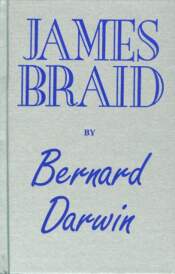
$35.00Add to cart
By Bernard Darwin The story of one of the Triumvirate who, at the turn of the century, along with Taylor and Vardon, elevated the game from a Scottish curiosity to a level of unimaginable popularity. Foreword by Bernard Darwin. -
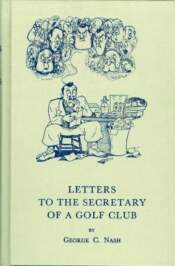 By George Nash An underground classic for decades, this is a truly hilarious account of the breaking of the mental health of the secretary of a British golf club because of the incessant threats and sabotages by club members such as the ferocious General Sir Armstrong Forcursue. Upon his appointment, the Job-like Secretary, Patrick Whelk, receives this note: “Dear Sir, I hear that you are the new Secretary. May Heaven Help You.” Foreword by Robert S. Macdonald.
By George Nash An underground classic for decades, this is a truly hilarious account of the breaking of the mental health of the secretary of a British golf club because of the incessant threats and sabotages by club members such as the ferocious General Sir Armstrong Forcursue. Upon his appointment, the Job-like Secretary, Patrick Whelk, receives this note: “Dear Sir, I hear that you are the new Secretary. May Heaven Help You.” Foreword by Robert S. Macdonald. -
 Edited by Peter Ryde--a brilliant collection of Darwin One of the inescapable charms of Darwin’s writings is his ability to see with the eyes of a child while thinking with the mind of a highly educated adult. An Attack of Socketing is Darwin at his impish best. At worst, it is a story going nowhere; at best, it is a story that ends up where it began. Read how an attack of the “shanks” or “socketing” (when the ball goes dead right at impact for a right-handed player) can and does infect the average and best players. Hogan at Carnoustie, the immortal James Braid, Ouimet at Brookline, Bobby Jones in quest of the Grand Slam and after his announced retirement: all are the subjects of wonderful pieces. However, the more obscure Darwin becomes in search of a topic, the better the results. Take When Slices were Slices, which contains no advice, although it is loosely about the six different types of slices Seymour Dunn describes in Standardised Golf Instruction. Sensitive of his reader’s game, Darwin avoids detailing the six slices “because to read a medical book is to invariably to believe that one has got every disease under the sun.”
Edited by Peter Ryde--a brilliant collection of Darwin One of the inescapable charms of Darwin’s writings is his ability to see with the eyes of a child while thinking with the mind of a highly educated adult. An Attack of Socketing is Darwin at his impish best. At worst, it is a story going nowhere; at best, it is a story that ends up where it began. Read how an attack of the “shanks” or “socketing” (when the ball goes dead right at impact for a right-handed player) can and does infect the average and best players. Hogan at Carnoustie, the immortal James Braid, Ouimet at Brookline, Bobby Jones in quest of the Grand Slam and after his announced retirement: all are the subjects of wonderful pieces. However, the more obscure Darwin becomes in search of a topic, the better the results. Take When Slices were Slices, which contains no advice, although it is loosely about the six different types of slices Seymour Dunn describes in Standardised Golf Instruction. Sensitive of his reader’s game, Darwin avoids detailing the six slices “because to read a medical book is to invariably to believe that one has got every disease under the sun.” -
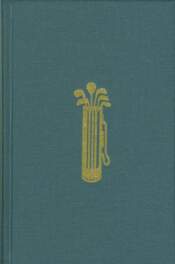 By Percy Boomer "This is not a book," wrote Percy Boomer, "on the science of golf, but about learning it. Everything in the science of the game has been written, little on how to learn it. So I outline a method of learning and stress certain points about the golf swing." Boomer teaches you how the correct golf swing feels in all its component parts. Once you know how it feels you can train your body to duplicate that feel and you can accept or reject advice from anyone on the basis of its feel. The idea is to find the way to take the cerebral cortex, so to speak, out of the swing and to make it a part of our instinctual life.
By Percy Boomer "This is not a book," wrote Percy Boomer, "on the science of golf, but about learning it. Everything in the science of the game has been written, little on how to learn it. So I outline a method of learning and stress certain points about the golf swing." Boomer teaches you how the correct golf swing feels in all its component parts. Once you know how it feels you can train your body to duplicate that feel and you can accept or reject advice from anyone on the basis of its feel. The idea is to find the way to take the cerebral cortex, so to speak, out of the swing and to make it a part of our instinctual life. -
 By Bernard Darwin A must have edition for the Darwin fan! It is hard to believe how well Darwin writes until you open this volume at any short chapter and get whisked off on Darwin’s magic carpet to wherever he wants to take you. No wonder his writing has lost none of its immediacy. He makes you understand and appreciate the game on a deep emotional level. It’s what has made him the greatest golf writer ever and, some think, the greatest writer on sport. Reading Darwin is one of the most pleasurable aspects of an involvement in golf. It makes you feel almost as good as hitting a long, straight drive. Here's an excerpt from the review on Cybergolf.com: "Out of the Rough is a superb collection of Bernard Darwin's columns from the early 1930s. The columns include some of Darwin's all-time classics, including “Old Pawky,” where he talks about Willie Park's wooden putter; “Hail and Farewell,” in which Darwin discusses Bobby Jones' retirement, and “The Best Ever,” where Darwin describes the best golfer in history. Darwin's observations on golf are unfailing, which help make him a great read today, some 70 years after these columns were written. This book is a faithful reproduction of the original, beautifully captured in a traditional Smyth-sewn, hardcover binding. Early editions of the book sell for $700 and more. Foreword by Henry Longhurst.
By Bernard Darwin A must have edition for the Darwin fan! It is hard to believe how well Darwin writes until you open this volume at any short chapter and get whisked off on Darwin’s magic carpet to wherever he wants to take you. No wonder his writing has lost none of its immediacy. He makes you understand and appreciate the game on a deep emotional level. It’s what has made him the greatest golf writer ever and, some think, the greatest writer on sport. Reading Darwin is one of the most pleasurable aspects of an involvement in golf. It makes you feel almost as good as hitting a long, straight drive. Here's an excerpt from the review on Cybergolf.com: "Out of the Rough is a superb collection of Bernard Darwin's columns from the early 1930s. The columns include some of Darwin's all-time classics, including “Old Pawky,” where he talks about Willie Park's wooden putter; “Hail and Farewell,” in which Darwin discusses Bobby Jones' retirement, and “The Best Ever,” where Darwin describes the best golfer in history. Darwin's observations on golf are unfailing, which help make him a great read today, some 70 years after these columns were written. This book is a faithful reproduction of the original, beautifully captured in a traditional Smyth-sewn, hardcover binding. Early editions of the book sell for $700 and more. Foreword by Henry Longhurst. -
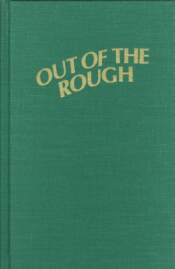 By Joseph T. Shaw An absolutely irresistible story about a young American who travels to Elie, in the kingdom of Fife, to learn the game from a master and win the girl he loves. Needless to say, his dreams change rather radically in Scotland. All the characters are brought beautifully and authentically to life. A lovely read.
By Joseph T. Shaw An absolutely irresistible story about a young American who travels to Elie, in the kingdom of Fife, to learn the game from a master and win the girl he loves. Needless to say, his dreams change rather radically in Scotland. All the characters are brought beautifully and authentically to life. A lovely read. -
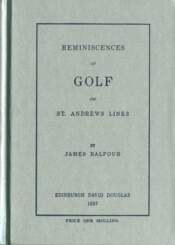 By James Balfour One of the rarest and most sought-after golf books ever produced. It is one of the earliest first-hand accounts of golf at St. Andrews. It begins in the feather ball era and concludes in the 1880s. This is a high grade reproduction of this delicate 127 year old book that is listed in Gilchrist's Guide to Golf Collectibles at $7,000. Foreword by Herbert Warren Wind, Afterword by Jack Nicklaus
By James Balfour One of the rarest and most sought-after golf books ever produced. It is one of the earliest first-hand accounts of golf at St. Andrews. It begins in the feather ball era and concludes in the 1880s. This is a high grade reproduction of this delicate 127 year old book that is listed in Gilchrist's Guide to Golf Collectibles at $7,000. Foreword by Herbert Warren Wind, Afterword by Jack Nicklaus -
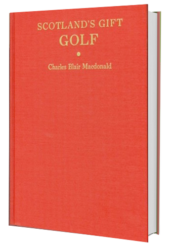
$65.00Add to cart
By Charles B. Macdonald One of the masterpieces of golf literature by America's first official golf champion and one of its foremost golf architects. Afterword by Alister Cooke. -

$50.00Add to cart
By H.N. Wethered and T. Simpson The Architectural Side of Golf, written at the close of the golden era of golf architecture, is the discipline’s grandest literary gem. It is the last and most lavish of the several books on design published during the 1920s, with 44 plates drawn by Simpson and 26 etchings by Wethered. The authors reaped the benefit of seeing prior publications and crafted this to be as little like a textbook as possible, while exploring a wide variety of subjects directly and indirectly related to architecture. Excepting Sutton’s 1933Golf Courses: Design, Construction and Upkeep, this would be the last book published on golf course architecture for decades. Familiar to designers, The Architectural Side of Golf should also be in the hands of amateurs and committee persons who tinker with re-design or contemplate alteration of their home courses. The authors surmise the golf course is at a crossroads. In the 1920s, they say, gone are the carefree days of yore when the players were “a mere handful of local enthusiasts who did not, perhaps, take the game in quite as serious a spirit as is the present custom.” The modern ball and clubs produce better, longer shots of controlled shapes in the hands of the pros. Match play has given way to stroke play and thus increased attention to every strike. This is modern golf, attacking all the time, shooting for the pin. The best players now practice regularly—even putting—and thereby invent all manners of shots to escape trouble. The authors ponder how an architect can defend the onslaught against par. In the beginning of the 21st century, we frequently hear critics argue, “today’s golf ball goes too far.” Distance was as hot a topic in the Roaring Twenties as it is now. How accurate Simpson and Wethered were in their prediction about balls: “In all probability there is still room for an additional length quite sufficient to upset present calculations.” Another concern for architects of that era—and this—is the degree to which wedge play had been perfected. The design solutions for today are as then. In the search to frustrate the constantly dropping scores, success is not to be found in lengthening the holes—the ball will keep going further. Rather, allow semi-rough come into play more, make primary rough penal; reduce the size of the greens and remove backdrops that provide clues to distance; let every bunker and hazard be strategic. Finally, keep everything in proportion caution the authors. Remember that only one percent of golfers are “cracks” and the average guys are the ones who really keep the club afloat. Wethered and Simpson challenge all designers not to fail in any of the obvious points for building courses: every hole should be interesting; the maximum variety of holes allowed by the site should be provided; the natural beauty of the country should be impaired as little as possible; a premium should be put on good golf; and the course should be equally interesting and amusing to the first-rate and the second-rate golfer. The discipline needed to abide by these hard and fast rules is more than many architects have been able to muster. One of the outstanding features of this book is the use of hole and feature drawings to illustrate the text, many from courses unvisited by even the most ardent seekers, like Chantilly, Liphook, Waddesdon, Chiberta-Biarritz, and Morfontaine. The effect of this feature is most evident in the authors’ interesting discussion about the ideal golf course. Before presenting their favorite 18, and they are all winners, Wethered and Simpson firmly denounce any attempt to actually build such a composition course. Suppose, they say, every hole was of a strength and character of the 17th at St. Andrews Old: “The strain of it all!…It would certainly break our hearts and leave us nervous wrecks or golf lunatics in real earnest.” We can all join in this pleasant theoretical exercise. This is an especially nice book if you like St. Andrews. Different chapters cover the South of England, Northern Scotland, and East Lothian, but the authors clearly are enamored with the Old Course. Many of the references throughout the text relate to the venerable links, especially so in the unique section entitled The Reversible Golf Course. There is camaraderie amid history and philosophy, notably in the chapterCaddies We have Met. One particular caddie had “the appearance of a bird of prey, with hooked nose and fierce bright eyes glimmering at one, and a look that was commanding yet inscrutable…carried the clubs under his arm in the old manner, as if prepared to charge the enemy with the bayonet at the least provocation.” Having been treated with diplomatic firmness throughout the round, the author felt it “expedient to dribble a small stream of silver into his palm until there were signs of a sufficiency to appease his humour.” Equally imaginative—and surprisingly prescient on the topic of architecture—is a chapter on home golf,In an English Garden. The often subtle but pervasive philosophy in The Architectural Side of Golf is as important and sound as the technical advice. The new culture of golf began in a whirl when vastly more people began to play, equipment improved dramatically and courses were routinely constructed inland. Whatever it was before, golf became a blend, an amalgamation of art and science. More than anything, it became paramount that the architect be alert to their proper balance. Science can overpower the artistry of man imitating nature, just as seeking perfection in artistry can confound science. Given the fluid nature of golf and its components, it is a testimony to the value of this work that its subjects remain germane in any given greens committee meeting today. Foreword by Herbert Warren Wind. -
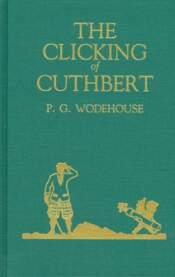 By P. G. Wodehouse Many have tried to explain why Wodehouse's golf stories are so utterly enjoyable and so far above anyone else's efforts in the genre. They are the product of a genius who wrote over ninety books and who created two of the greatest fictional characters in the English language: the dim-witted but loveable Bertie Wooster, and his valet, the amazingly ingenious Jeeves. The Clicking of Cuthbert is Wodehouse's first collection of golf stories, published in England in 1922. We have reproduced the cover of the original English edition but have used the text of the American edition, which was called Golf without Tears. One of the things that may strike you as odd is how much and how immediately you will like these stories. You will even find yourself laughing aloud. "Odd" because normally when such pleasure is presented to us we become suspicious. What is the hidden message? What does he really want of us? What's he getting at? Where's the deeper meaning? There is no deeper meaning in Wodehouse. His deeper meaning is the pleasure and satisfaction that is felt by his readers - genuine pleasure and genuine satisfaction that comes and can only come from the recognition of the truth of a given situation and a given character. In order to produce so many laughs and so many smiles Wodehouse had to be a master of his craft. There was none finer, and no one worked harder to achieve that mastery. His prose style was deceptively simple and clear. As John Updike observed in a recent magazine article, he knew his golf.: "Wodehouse's grasp of the strange joy and fascination of the game is absolute." Sir Peter Allen, gifted golfer, writer, traveler, and industrialist has evoked in his Afterword what the world of golf was like in the early 1920s, the world P.G. Wodehouse studied for these stories. Herbert Warren Wind's Foreword is a sparkling biography of Wodehouse and a splendid way to start the book. Wind did a profile of Wodehouse for The New Yorker magazine and spent a good deal of time with him while researching his essay. It was later published in book form in England under the title, The World of P.G. Wodehouse. Foreword by Herbert Warren Wind, Afterword by Sir Peter Allen.
By P. G. Wodehouse Many have tried to explain why Wodehouse's golf stories are so utterly enjoyable and so far above anyone else's efforts in the genre. They are the product of a genius who wrote over ninety books and who created two of the greatest fictional characters in the English language: the dim-witted but loveable Bertie Wooster, and his valet, the amazingly ingenious Jeeves. The Clicking of Cuthbert is Wodehouse's first collection of golf stories, published in England in 1922. We have reproduced the cover of the original English edition but have used the text of the American edition, which was called Golf without Tears. One of the things that may strike you as odd is how much and how immediately you will like these stories. You will even find yourself laughing aloud. "Odd" because normally when such pleasure is presented to us we become suspicious. What is the hidden message? What does he really want of us? What's he getting at? Where's the deeper meaning? There is no deeper meaning in Wodehouse. His deeper meaning is the pleasure and satisfaction that is felt by his readers - genuine pleasure and genuine satisfaction that comes and can only come from the recognition of the truth of a given situation and a given character. In order to produce so many laughs and so many smiles Wodehouse had to be a master of his craft. There was none finer, and no one worked harder to achieve that mastery. His prose style was deceptively simple and clear. As John Updike observed in a recent magazine article, he knew his golf.: "Wodehouse's grasp of the strange joy and fascination of the game is absolute." Sir Peter Allen, gifted golfer, writer, traveler, and industrialist has evoked in his Afterword what the world of golf was like in the early 1920s, the world P.G. Wodehouse studied for these stories. Herbert Warren Wind's Foreword is a sparkling biography of Wodehouse and a splendid way to start the book. Wind did a profile of Wodehouse for The New Yorker magazine and spent a good deal of time with him while researching his essay. It was later published in book form in England under the title, The World of P.G. Wodehouse. Foreword by Herbert Warren Wind, Afterword by Sir Peter Allen. -
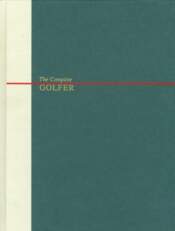 Edited by Herbert Warren Wind Odds are against you in most games of chance. But if you ever wanted a sure bet, give this book to any golfer as a gift. It is similar to lunch at Muirfield; many choices through many courses, all worthy of the finest table, and all shared convivially. As such, it is sure to satisfy every palate. Open The Complete Golfer anywhere and you are very likely to find something you enjoy. The reason is due largely to the wonderful choices made for this anthology by editor Herbert Warren Wind. A quality miscellany requires good selection by the compiler, a success often determined by their breadth of knowledge on the subject. Wind was in his best form in the early 1950s after writing The History of American Golf (a Classics of Golf title) and joining the staff of the New Yorker in 1949. He spent two years researching the literature of golf for his top picks in a variety of disciplines for this volume. Bobby Jones writes in the original introduction, “Golf has more than enough in it to command the respect of any man.” Considerable literature will develop around such a game continues Jones, “History, humor, curiosities, stories of championships, essays on methods…and every golfer, I think, owes it to himself to have an acquaintance with this literature.” To ease into this familiarity, Wind begins lightheartedly with fiction and a selection of cartoons. This seemingly innocent beginning is good preparation for the meatier third section The Spirit of the Game with history, comments, reminiscences and some humor. Francis Ouimet gives an intimate view of growing up across the street from the country club; how he would sneak on and play until discovered and chased by the greenkeeper. H. B. Martin tells us how golf came into American legitimacy with the 1888 formation of The Saint Andrew’s Golf Club in Yonkers, NY, and how the “Old Apple Tree Gang” received its name. Grantland Rice’s article for The American Golfer (see the Classics of Golf selection by the same title for many more articles) is one of the most insightful ever written on Bobby Jones’ preparation for his record-setting Grand Slam year. Rice prophetically closes The Prospect for 1930 with: “There is at least a first class chance that this will be the best year he has ever had, and that will mean the best year any individual golfer ever had.” If Jones is your cup of tea, you will read and reread Bernard Darwin’s The Immortal Bobby, one of the best pieces ever written on the man. Another famous Jones, Robert Trent Jones, contributed an excellent chapter of substance on golf course architecture entitled From St. Andrews to the Modern American Courses. He offers an overview of the history of his craft but focuses on several modern courses to explain current theory. The discussions are facilitated by the inclusion of a series of color course maps. Pinehurst No. 2, Pine Valley, Merion, Pebble Beach, Augusta National, The National Golf Links, and Oakland Hills are detailed and studied in comparison with The Old Course. One other course is omitted from that list, not to slight it because only one hole was used, but to single it out. It is uniquely significant in Jones’ view; it is the only other hole he discusses from all the remaining courses in Britain. “The Redan—the fifteenth hole at North Berwick—takes its name from the famous redoubt at Sevastopol, which the British stormed in 1855…the Redan holds a salient position in the development of golf architecture. It was one of the first holes to demonstrate the beauties of strategic design so forcibly that it was copied at many other courses, and it became a touchstone for golf course layout.” The section on Great Players, Historic Moments has enough stories for a dozen Hollywood movies. Walter Travis writes on how he won the Amateur Championship. Byron Nelson is profiled immediately after he broke the PGA record for consecutive tournament wins with six (Nelson was on his way to an insurmountable record of 11 victories in a row—he was that good.) One article exemplifies the type of attitude that is presently lost from the professional game: star player Gene Sarazen writes a heartfelt article about Walter Hagen– My Hero, My Rival exhibiting sportsmanship befitting a gentleman. In an autobiographical piece, Sarazen also relates how he played the last 28 holes of the 1932 U. S. Open in 100 strokes, over a tough Tillinghast layout. Even those who do not like, or do not think they need instruction will benefit from The Masters’ Voices. Wind does not select staid instructors who might begin with “Now place your hand on the club…” Wind offers Willie Park, Jr., on The Importance of Style; How Hogan Picks His Clubs by his pal Jimmy Demaret; and It Takes Brains to Play Golf by Gene Sarazen. The list of able contributors and engaging methods is, as in prior chapters, impressive and important. There are many fine excerpts, columns, stories and recollections not mentioned here for you to discover at your leisure. Whether enjoyed by article or chapter, The Complete Golfer offers as diverse and excellent a selection of golf literature as one might reasonably put between the covers of a book. Forewords by Herbert Warren Wind and Robert T. Jones, Jr., Afterword by Frank Hannigan
Edited by Herbert Warren Wind Odds are against you in most games of chance. But if you ever wanted a sure bet, give this book to any golfer as a gift. It is similar to lunch at Muirfield; many choices through many courses, all worthy of the finest table, and all shared convivially. As such, it is sure to satisfy every palate. Open The Complete Golfer anywhere and you are very likely to find something you enjoy. The reason is due largely to the wonderful choices made for this anthology by editor Herbert Warren Wind. A quality miscellany requires good selection by the compiler, a success often determined by their breadth of knowledge on the subject. Wind was in his best form in the early 1950s after writing The History of American Golf (a Classics of Golf title) and joining the staff of the New Yorker in 1949. He spent two years researching the literature of golf for his top picks in a variety of disciplines for this volume. Bobby Jones writes in the original introduction, “Golf has more than enough in it to command the respect of any man.” Considerable literature will develop around such a game continues Jones, “History, humor, curiosities, stories of championships, essays on methods…and every golfer, I think, owes it to himself to have an acquaintance with this literature.” To ease into this familiarity, Wind begins lightheartedly with fiction and a selection of cartoons. This seemingly innocent beginning is good preparation for the meatier third section The Spirit of the Game with history, comments, reminiscences and some humor. Francis Ouimet gives an intimate view of growing up across the street from the country club; how he would sneak on and play until discovered and chased by the greenkeeper. H. B. Martin tells us how golf came into American legitimacy with the 1888 formation of The Saint Andrew’s Golf Club in Yonkers, NY, and how the “Old Apple Tree Gang” received its name. Grantland Rice’s article for The American Golfer (see the Classics of Golf selection by the same title for many more articles) is one of the most insightful ever written on Bobby Jones’ preparation for his record-setting Grand Slam year. Rice prophetically closes The Prospect for 1930 with: “There is at least a first class chance that this will be the best year he has ever had, and that will mean the best year any individual golfer ever had.” If Jones is your cup of tea, you will read and reread Bernard Darwin’s The Immortal Bobby, one of the best pieces ever written on the man. Another famous Jones, Robert Trent Jones, contributed an excellent chapter of substance on golf course architecture entitled From St. Andrews to the Modern American Courses. He offers an overview of the history of his craft but focuses on several modern courses to explain current theory. The discussions are facilitated by the inclusion of a series of color course maps. Pinehurst No. 2, Pine Valley, Merion, Pebble Beach, Augusta National, The National Golf Links, and Oakland Hills are detailed and studied in comparison with The Old Course. One other course is omitted from that list, not to slight it because only one hole was used, but to single it out. It is uniquely significant in Jones’ view; it is the only other hole he discusses from all the remaining courses in Britain. “The Redan—the fifteenth hole at North Berwick—takes its name from the famous redoubt at Sevastopol, which the British stormed in 1855…the Redan holds a salient position in the development of golf architecture. It was one of the first holes to demonstrate the beauties of strategic design so forcibly that it was copied at many other courses, and it became a touchstone for golf course layout.” The section on Great Players, Historic Moments has enough stories for a dozen Hollywood movies. Walter Travis writes on how he won the Amateur Championship. Byron Nelson is profiled immediately after he broke the PGA record for consecutive tournament wins with six (Nelson was on his way to an insurmountable record of 11 victories in a row—he was that good.) One article exemplifies the type of attitude that is presently lost from the professional game: star player Gene Sarazen writes a heartfelt article about Walter Hagen– My Hero, My Rival exhibiting sportsmanship befitting a gentleman. In an autobiographical piece, Sarazen also relates how he played the last 28 holes of the 1932 U. S. Open in 100 strokes, over a tough Tillinghast layout. Even those who do not like, or do not think they need instruction will benefit from The Masters’ Voices. Wind does not select staid instructors who might begin with “Now place your hand on the club…” Wind offers Willie Park, Jr., on The Importance of Style; How Hogan Picks His Clubs by his pal Jimmy Demaret; and It Takes Brains to Play Golf by Gene Sarazen. The list of able contributors and engaging methods is, as in prior chapters, impressive and important. There are many fine excerpts, columns, stories and recollections not mentioned here for you to discover at your leisure. Whether enjoyed by article or chapter, The Complete Golfer offers as diverse and excellent a selection of golf literature as one might reasonably put between the covers of a book. Forewords by Herbert Warren Wind and Robert T. Jones, Jr., Afterword by Frank Hannigan


